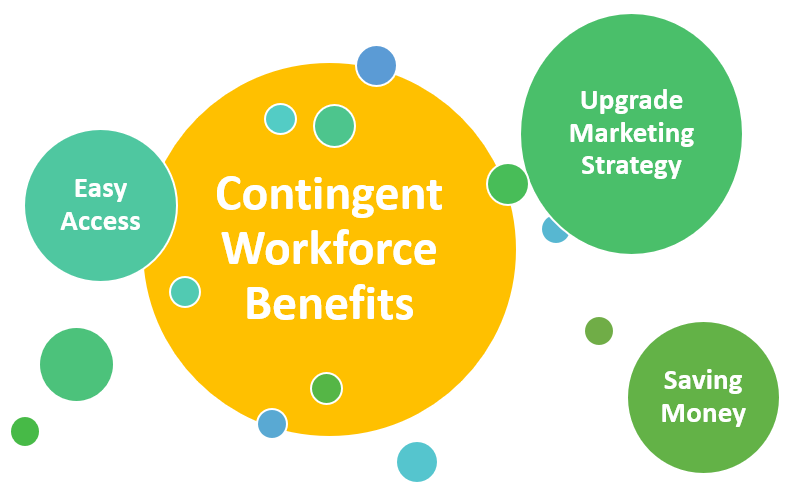Typically, employees are dedicated on some level to their company. When one has a fulltime esc position, they usually strive to stay at the company as long as they enjoy the workplace. Due to certain work demands, employee expectations are beginning to change. Permanent workers will always be a part of the job world. Though, new workforce management patterns have shown that hiring workers less dedicated to a job has been a common workplace trend. This is what is known as a contingent workforce. Here is your guide to contingent workforce management.
What is Contingent Workforce Management?

Contingent workforce management is an approach that includes hiring temporary workers. These temporary workers are hired to add flexible resources to a company. There is an influx of individuals seeking out extra work. Since times are tough, many desire to have a side hustle type of job to earn more income. This developing workstyle has inspired businesses to test out contingent workforce management. Contingent labor allows employees to utilize flexible workplace models. This benefits both the employee and management team. Workers are constantly leaving jobs due to a variety of reasons. Loss of employees causes businesses tons of money.
Through hiring contingent workers, a company can save money and easily fill empty positions. Those who earn a contingent based position are most often on a fixed agreement. This means their time at the company and responsibilities have an assigned end date. Contingent employees aren’t identified as officially part of a business team. They are simply there to fill the high demand positions for quickly growing companies. Collectively, contingent workforce management refers to any type of job role that doesn’t pertain to a permanent and consistent model.
Now that you understand more about contingent workforce management, it’s time to consider how managing a contingent workforce could benefit you.
Why You Should Manage the Contingent Workforce?
When a workplace consists of unreliable, underqualified, and weak employees, it will suffer. Gaining the extra support from contingent workers is a swift way to combat any employee based issues your business endures. Often, employees will abuse their options within a business. Employee abuse of power may include: always calling in, making excuses, blaming coworkers, and not taking a job seriously. Though employees who are not part of management don’t have the right to make crucial decisions, they still can abuse power.
The behavior of an employee always impacts the business they are working for. Whether it be a positive or negative outcome, the actions of an employee are critical to the function of all businesses and companies. Modern workplaces seem to be lacking motivated employees who work to their limit. This is why considering managing a partially or dominantly contingent workforce can benefit your company.
Hiring employees in this workforce era is a painful process. Online applications can often be deceiving. Many can lie about who they claim to be as an employee. Many workers also aren’t passionate or dedicated to their work in any shape or form. Adapting to a contingent based workforce is a simple way to provide your business with people who can successfully complete tasks. Those working on a term prefer that style of work. Committing to a business isn’t easy. Contingent workers don’t have to worry about any attached strings, and can relax knowing that they know when they will be done with a job.
There are millions of freelancers online that are willing to work for any business. You’ve likely heard about freelancing as a business manager. Freelancers are individuals who may pick up long term work, but also work for clients who provide them with short-term projects. The projects can either be long term or one-off contracts. Attempting contingent workforce management is a worthwhile investment you can make to support your company. You can keep your hard workers and hire employees on a contingent based agreement to fill in the gaps. While permanent employees are the foundation of your workplace, temporary employees are just as valuable.
If you relate to a messy employee team where goals are unobtained, managing a partial or dominant contingent workforce is a possible solution to this business flaw.
Contingent Based Workforce Benefits

Contingent based workers can benefit your business in plenty of ways. Modern times call for updated management practices. When you are responsible for the operations of a company, you need to rely on your ability to make adequate choices that increase the success of your workplace. Here is how a contingent based workforce can benefit your business.
Easy Access to Potential Candidates
There are limitless possibilities to the amount of candidates you can obtain through online resources. Posting on a freelance platform, job search site, social media, or your website can lead you to a sea full of potential employees who can fulfill a contingent workforce role. From writing to design, the freelance world has tons of talented individuals who would love to do some short-term work for your business. Utilizing platforms like LinkedIn can even allow you to grow a following of those looking for side hustles and quick jobs. Don’t fail to optimize your virtual resources. Finding employees online is simpler and less of a challenge. The employee pool and ease of both communication and access makes contingent workforce management beneficial to your business.
Upgrading The Digital Marketing Strategy
All businesses can undoubtedly benefit from the wonders of digital marketing. Not only is digital marketing cost effective, it’s also an efficient way to market your business. The online consumer market is ever growing. You can hire a team of contingent workers to help upgrade your digital marketing strategy. This will result in positive results such as increase in customers, reaching or succeeding sales targets, profitable ad campaigns, and a boost in the popularity of your businesses. There are countless individuals who specialize in marketing for companies. Many of these individuals like to take on multiple jobs. Take advantage of this opportunity, and utilize contingent workforce management to grow the face of your brand digitally.
Saving Money on Employee Costs
Due to the fact that employees on a contingent based contract aren’t officially part of a company, you can save money on a multitude of factors. Employees who stay for the required duration at a business who are signed to a permanent contact have access to benefits. Healthcare, tuition reimbursement, paid work trips, and other benefits cost corporations from millions of dollars each year. Employers are not required to provide contingent based employees with these benefits. By avoiding the extra costs, you can put the money towards business operations and meeting goals. You also are able to save money by avoiding a lengthy training process. Most workers that you will end up hiring temporarily will already be well equipped and prepared for the job role. This saves you time and energy that can be put towards other things.
What Are Some of the Key Challenges?
Doesn’t Work for All Types of Businesses
Unfortunately, contingent workforce management isn’t fit for every type of business. This means that you must be careful before you decide on adopting this strategy into your hiring practices. For example, a grocery store should never hire contingent based employees. There are people shopping for groceries daily, therefore multiple workers are needed to assist consumers. Another problem is that most of the work done in a grocery store is done in person. It would not make any sense for a manager to use contingent based workforce management at a business like this. Repair shops, medical clinics, schools, and other similar job fields should stray away from hiring flexible employees in most instances. A contingent workforce management approach is better suited for office based business and companies that operate primarily online.
Problems with The Interview & Screening Process
A huge flaw of online jobs applications is that many who apply for jobs are unfit candidates. This means that a majority of those who applied for your business’ digital job postings are unfit, underqualified, and unmatched for the role. This outcome is truly frustrating for management who want to test out contingent workforce approaches. Not only do you have to deal with unfit candidates applying for your positions, the hiring process can also be an inconvenience.
Hiring in person allows you to have an in person interview with your client. Online interviews are less genuine, and can negatively impact connection and networking. Though this is not the biggest problem with the digital interview and screening process. Those looking for jobs online can often lie about who they are more easily. Even if you do a background check, it’s harder to trust employees found via the internet. Anyone can easily make up a cover letter about their capabilities. Someone can claim anything they want, and submit deceiving examples of “their” work. This is why you have to be cautious and check to see if those you are interviewing actually gave your proof of their skills. Freelancers sometimes plagiarize their portfolio and take advantage of companies looking for contingent based employees. Never trust an applicant until you confirm they are reliable. Do an in depth interview and test their skills before ever hiring an employee this way.
Legal Implications
There are several legal implications for those hiring temporary workers. Contingent workforce management is not as controlled as standard workforce management. This means that if an employee doesn’t turn out to be in good standing, that they can easily get away from any consequences. Depending on the laws of your state or country, and conditions of the short-term contract, employees can have any amount of power to abuse their position. Employees can therefore get away with non-compliance, hurting the success of a business. Legal implications usually occur at any business. This means that you can move past any legal trouble, and recover from missteps.
When Does a Contingent Workplace Make Sense?
A contingent workplace certainly doesn’t make sense for every business. This is why you need to be careful, and avoid trying out contingent workforce management if it won’t benefit your company. If you have a reliable team of employees who get their work done efficiently, there would be no point in hiring extra support. Take a moment to think about your workplace. Is there a demand for short-term workers? Do you often deal with short staff and struggle to hire permanent employees? Can you apply the benefits of hiring contingent based workers to your business? If you said yes to any of these questions, a contingent workplace may make sense to your management team. Here are some scenarios where hiring a contingent based worker can be useful.
Medical Leave
Important employees may unexpectedly have to leave work for a medical leave. This immediately creates an open position that an employer has to fill. A planned medical leave such as a maternity leave will leave a management team with more time to hire a temporary worker. If you can find someone online to fill a position in this case, then you should try contingent workforce management.
Jury Duty
Citizens have no control over attending jury duty. You may lose an employee momentarily due to them having to fulfill their legal responsibility. This may happen at the busiest business period of the year. Hiring a contingent based worker to continue that employee’s work would be a smart move.
Other random occurrences, and unreliable workers create a demand for the use of contingent workforce management.
Creating and Managing Contingent Workforce
Contingent workforce management is a style of managing. You can focus on managing a contingent workforce alone, or using multiple styles of management. Realistically, starting off with hiring a small amount of unofficial employees is your best move. Slowly ease into trying contingent workforce management. Taking things step by step will allow you to successfully create and manage your own contingent workforce.


